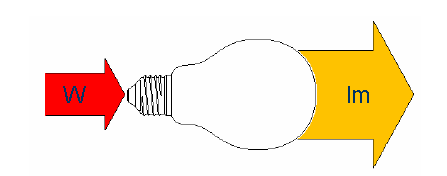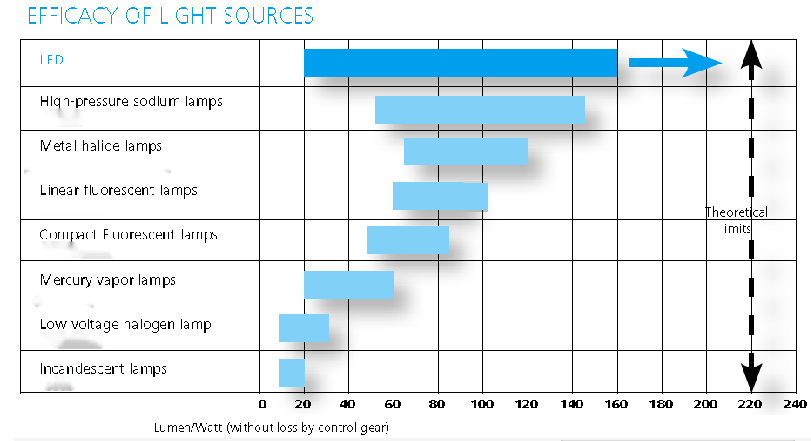Are LED Lamps Really Energy Efficient?
Before this, the lighting industry has never been so beautiful. Needless to say in the industry, under the general environment and trend of energy saving, emission reduction and green environmental protection, it is an industry consensus and the general trend that LED will become the mainstream light source of future lighting.
Even in the street talk of the consumer market, when it comes to LED lighting, although most of them have a little understanding, they are well known. This half is naturally due to the government’s strong support and promotion, and the other half is also due to the advantages and charm of LED technology itself.
In the eyes of the general public, as a new lighting technology, LED has basically been equated with energy saving. The only hurdle at the moment seems to be price. Even, the price is no longer an issue. However, are LED lamps really energy efficient?
1. Light Source Efficiency
LED is a light-emitting diode, a solid-state semiconductor component that can convert electrical energy into visible light. Just as the traditional incandescent and halogen lamps are behind the thermal radiation luminescence principle, and the fluorescent lamps, mercury lamps, sodium lamps and metal halide lamps use the gas discharge principle, the LED itself represents a technology and a luminous principle.
Light Efficiency: The ability of an illuminant to convert electrical energy into visible light. It is measured by the ratio of luminous flux to power, and the unit is lm/w.
The efficiency comparison of common light source products on the market corresponding to various lighting principles is shown in the following table:
As can be seen from the above table, LED technology, as a new type of lighting source, is more advanced than traditional lighting technology. The LED energy saving we usually talk about is also judged at this level.
In fact, to judge whether a lamp is energy-saving, it is far more than the technology and light source used. But even so, LED technology has a wide range of luminous efficacy, and it would be inaccurate to say that LED light sources are more energy efficient than other light sources in general. This is like saying that the French are romantic, the Chinese are hard-working, and the Japanese are disciplined. It is unscientific. When we get along, we have to see what kind of French, Chinese and Japanese the other person is. The same is true for LED products.
2. Electrical Energy Efficiency
In addition to incandescent lamps and line voltage halogen lamps, other light sources need to be equipped with lighting appliances. Lighting appliances also have the problem of power utilization, that is, the ratio of the electrical energy used by the electrical appliances from the grid to drive the light source to emit light.
Without considering harmonics, the power factor λ is usually represented by cosφ. It doesn’t matter if you don’t understand these. In short, the efficiency of lighting appliances usually depends on the power factor index.
3. Lighting Efficiency
The efficiency of lamps is easy to understand. In simple terms, it is the ratio of the light coming out of the lamp to the light coming out of the light source under standard conditions, usually expressed by LOR. LOR = luminous flux emitted by the luminaire / luminous flux of the light source in the luminaire. For example, for an ordinary 3*18W lamp panel, the total luminous flux of the light source is 3600lm. If the measured luminous flux of the lamp is 1800lm, we say that the efficiency of the lamp is 50%.
4. Efficiency of Lighting System
If the lighting design process is divided into three parts: light selection, light distribution and light use, our discussion today is limited to the “light selection” part. Aside from the light distribution and light utilization rate of lamps, and whether the designer uses lamps reasonably in the space, to evaluate whether a lamp is energy-saving, it is necessary to combine the above three aspects to obtain the system efficiency of lamps:
Lamp system efficiency = luminous flux emitted by the luminaire/(light source power + electrical loss) = luminous flux emitted by the light source*LOR/(light source power + electrical loss).
5. Are LED Lamps Dnergy Efficient?
After clarifying the criteria for evaluating whether a lamp is energy-saving or not, as long as we find a suitable comparison object, we can judge the pros and cons of these two lamps.
Taking a brand of 3*14W grille lamps as an example, when it uses three 14W/1200lm lamps, equipped with a single-tube 14W ballast and a double-tube 2*14W ballast, the system power It is 18+32.5=50.5W. The efficiency of the grille light is LOR=70%, then the efficiency of the lighting system is 3600*70%/50.5W=49.9lm/W.
At this time, as long as the whole light efficiency (that is, the light efficiency of the lighting system) corresponding to the 3*14W replacement LED lamp is higher than 49.9lm/W, we can say that it is energy-saving.


